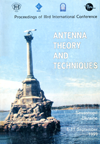Analytical calculation of detection and resolution thresholds in antenna arrays using sample covariance matrix eigenvalue technique
DOI:
https://doi.org/10.1109/ICATT.1999.1236187Abstract
Different algorithms based on the consideration of eigenvectors and eigenvalues of the sample covariance matrix are widely used for signal detection and estimating the number of sources. But classic eigenvalue technique makes difficult the evaluation of the thresholds for eigenvalues at given false alarm probabilities. To find these thresholds, it is necessary to know eigenvalue distribution functions of the sample covariance matrix. For some important tasks of signal detection and signals resolution the knowledge of statistical characteristics of only two maximum eigenvalues is enough for the appropriate choice of the thresholds.
In this work the cumulative distribution function (CDF) for the first (maximum) eigenvalue of the sample correlation matrix has been found in explicit form for case when only internal noise presents (for the null hypothesis in detection task). Also the approximate CDF of the second eigenvalue has been found for asymptotic case of one powerful external signal (for the null hypothesis in resolution task).
References
Karavaev, V.V.; Sazonov, V.V. Statistical Theory of Passive Location. Moscow: Radio and Communication, 1987 [in Russian].
Lee, H.B.; Li, Fu. An eigenvector technique for detecting the number of emitters in a cluster. IEEE Trans. Signal Processing, Sept. 1994, Vol. 42, No. 9.
Maltsev, A.A.; Ermolaev, V.T.; Rodushkin, K.V. Detection characteristics of antenna array using the maximum eigenvalue of the sample correlation matrix as solving statistic. Proc. of Int. Conf. JINA98, Nice, Nov. 1998.
Girko, V.L. Spectral Theory of Random Matrices. Moscow: Nauka, 1988 [in Russian].
Korn, G.A.; Korn, T.M. Mathematical Hand-Book for Scientists and Engineers. N.Y.: McGrow-Hill, 1961.

